Durability of Resin Bonding to Dental 3Y-TZP Zirconia Using Different Adhesive Systems
Abstract
1. Introduction
2. Materials and Methods
2.1. Specimen Preparation
2.2. Tensile Bond Strength Testing
2.3. Statistical Tests
2.4. Failure Mode
3. Results
4. Discussion
5. Conclusions
- The self-adhesive luting resin GC-ONE, as well as the conventional luting resin G-CEM LinkForce in combination with its specified primer G-Multi Primer, appeared most effective when bonding to zirconia and exhibited a stable performance after artificial aging.
- The use of the phosphate monomer-containing primer (Alloy Primer) did not statistically enhance the performance of any of the tested bonding systems.
- Artificial aging adversely affected the TBS values for all tested bonding systems.
Author Contributions
Funding
Institutional Review Board Statement
Informed Consent Statement
Data Availability Statement
Acknowledgments
Conflicts of Interest
References
- Edelhoff, D.; Sorensen, J.A. Tooth structure removal associated with various preparation designs for posterior teeth. Int. J. Periodontics Restor. Dent. 2002, 22, 241–249. [Google Scholar]
- Elsayed, A.; Younes, F.; Lehmann, F.; Kern, M. Tensile bond strength of so-called universal primers and universal multimode adhesives to zirconia and lithium disilicate ceramics. J. Adhes. Dent. 2017, 19, 221–228. [Google Scholar] [CrossRef] [PubMed]
- Zarone, F.; Russo, S.; Sorrentino, R. From porcelain-fused-to-metal to zirconia: Clinical and experimental considerations. Dent. Mater. 2011, 27, 83–96. [Google Scholar] [CrossRef] [PubMed]
- Edelhoff, D.; Stimmelmayr, M.; Schweiger, J.; Ahlers, M.O.; Güth, J.-F. Advances in materials and concepts in fixed prosthodontics: A selection of possible treatment modalities. Br. Dent. J. 2019, 226, 739–748. [Google Scholar] [CrossRef] [PubMed]
- Edelhoff, D.; Sorensen, J.A. Tooth structure removal associated with various preparation designs for anterior teeth. J. Prosthet. Dent. 2002, 87, 503–509. [Google Scholar] [CrossRef]
- Kallala, R.; Chaouch, M.H.; Nasr, K.; Courset, T. Step-by-step esthetic rehabilitation with chairside system. Case Rep. Dent. 2021, 2021, 5558158. [Google Scholar] [CrossRef]
- Marchesi, G.; Piloni, A.C.; Nicolin, V.; Turco, G.; Di Lenarda, R. Chairside CAD/CAM materials: Current trends of clinical uses. Biology 2021, 10, 1170. [Google Scholar] [CrossRef] [PubMed]
- Morimoto, S.; Rebello de Sampaio, F.B.; Braga, M.M.; Sesma, N.; Özcan, M. Survival rate of resin and ceramic inlays, inlays, and overlays: A systematic review and meta-analysis. J. Dent. Res. 2016, 95, 985–994. [Google Scholar] [CrossRef] [PubMed]
- Thordrup, M.; Isidor, F.; Hörsted-Bindslev, P. A prospective clinical study of indirect and direct composite and ceramic inlays: Ten-year results. Quintessence Int. 2006, 37, 139–144. [Google Scholar]
- Edelhoff, D.; Liebermann, A.; Beuer, F.; Stimmelmayr, M.; Güth, J.-F. Minimally invasive treatment options in fixed prosthodontics. Quintessence Int. 2016, 47, 207–216. [Google Scholar] [CrossRef] [PubMed]
- Bosch, G.; Ender, A.; Mehl, A. Non- and minimally invasive full-mouth rehabilitation of patients with loss of vertical dimension of occlusion using CAD/CAM: An innovative concept demonstrated with a case report. Int. J. Comput. Dent. 2015, 18, 273–286. [Google Scholar]
- Schlichting, L.H.; Resende, T.H.; Reis, K.R.; Magne, P. Simplified treatment of severe dental erosion with ultrathin CAD-CAM composite occlusal veneers and anterior bilaminar veneers. J. Prosthet. Dent. 2016, 116, 474–482. [Google Scholar] [CrossRef]
- Guess, P.C.; Selz, C.F.; Steinhart, Y.-N.; Stampf, S.; Strub, J.R. Prospective clinical split-mouth study of pressed and CAD/CAM all-ceramic partial-coverage restorations: 7-year results. Int. J. Prosthodont. 2013, 26, 21–25. [Google Scholar] [CrossRef] [PubMed]
- Magne, P.; Magne, M.; Belser, U.C. Adhesive restorations, centric relation, and the Dahl principle: Minimally invasive approaches to localized anterior tooth erosion. Eur. J. Esthet. Dent. 2007, 2, 260–273. [Google Scholar] [PubMed]
- Malament, K.A.; Socransky, S.S. Survival of Dicor glass-ceramic dental restorations over 16 years. Part III: Effect of luting agent and tooth or tooth-substitute core structure. J. Prosthet. Dent. 2001, 86, 511–519. [Google Scholar] [CrossRef] [PubMed]
- Denry, I.; Kelly, J.R. State of the art of zirconia for dental applications. Dent. Mater. 2008, 24, 299–307. [Google Scholar] [CrossRef] [PubMed]
- Guazzato, M.; Proos, K.; Quach, L.; Swain, M.V. Strength, reliability and mode of fracture of bilayered porcelain/zirconia (Y-TZP) dental ceramics. Biomaterials 2004, 25, 5045–5052. [Google Scholar] [CrossRef]
- Thammajaruk, P.; Inokoshi, M.; Chong, S.; Guazzato, M. Bonding of composite cements to zirconia: A systematic review and meta-analysis of in vitro studies. J. Mech. Behav. Biomed. Mater. 2018, 80, 258–268. [Google Scholar] [CrossRef] [PubMed]
- Piconi, C.; Maccauro, G. Zirconia as a ceramic biomaterial. Biomaterials 1999, 20, 1–25. [Google Scholar] [CrossRef]
- Thompson, J.Y.; Stoner, B.R.; Piascik, J.R.; Smith, R. Adhesion/cementation to zirconia and other non-silicate ceramics: Where are we now? Dent. Mater. 2011, 27, 71–82. [Google Scholar] [CrossRef] [PubMed]
- Hitz, T.; Stawarczyk, B.; Fischer, J.; Hämmerle, C.H.; Sailer, I. Are self-adhesive resin cements a valid alternative to conventional resin cements? A laboratory study of the long-term bond strength. Dent. Mater. 2012, 28, 1183–1190. [Google Scholar] [CrossRef] [PubMed]
- Mak, Y.-F.; Lai, S.C.; Cheung, G.S.; Chan, A.W.; Tay, F.R.; Pashley, D.H. Micro-tensile bond testing of resin cements to dentin and an indirect resin composite. Dent. Mater. 2002, 18, 609–621. [Google Scholar] [CrossRef] [PubMed]
- Holderegger, C.; Sailer, I.; Schuhmacher, C.; Schlapfer, R.; Hämmerle, C.; Fischer, J. Shear bond strength of resin cements to human dentin. Dent. Mater. 2008, 24, 944–950. [Google Scholar] [CrossRef]
- Passia, N.; Mitsias, M.; Lehmann, F.; Kern, M. Bond strength of a new generation of universal bonding systems to zirconia ceramic. J. Mech. Behav. Biomed. Mater. 2016, 62, 268–274. [Google Scholar] [CrossRef] [PubMed]
- Van Meerbeek, B.; Perdigão, J.; Lambrechts, P.; Vanherle, G. The clinical performance of adhesives. J. Dent. 1998, 26, 1–20. [Google Scholar] [CrossRef]
- Van Meerbeek, B.; Van Landuyt, K.; De Munck, J.; Hashimoto, M.; Peumans, M.; Lambrechts, P.; Yoshida, Y.; Inoue, S.; Suzuki, K. Technique-Sensitivity of Contemporary Adhesives. Dent. Mater. J. 2005, 24, 1–13. [Google Scholar] [CrossRef]
- Sadowsky, S.J. An overview of treatment considerations for esthetic restorations: A review of the literature. J. Prosthet. Dent. 2006, 96, 433–442. [Google Scholar] [CrossRef]
- Krämer, N.; Lohbauer, U.; Frankenberger, R. Adhesive luting of indirect restorations. Am. J. Dent. 2000, 13, 60D–76D. [Google Scholar]
- Özcan, M.; Nijhuis, H.; Valandro, L.F. Effect of various surface conditioning methods on the adhesion of dual-cure resin cement with MDP functional monomer to zirconia after thermal aging. Dent. Mater. J. 2008, 27, 99–104. [Google Scholar] [CrossRef]
- Papia, E.; Larsson, C.; du Toit, M.; Vult von Steyern, P. Bonding between oxide ceramics and adhesive cement systems: A systematic review. J. Biomed Mater. Res. B Appl. Biomater. 2014, 102, 395–413. [Google Scholar] [CrossRef]
- Tanış, M.; Akay, C.; Karakış, D. Resin cementation of zirconia ceramics with different bonding agents. Biotechnol. Equip. 2015, 29, 363–367. [Google Scholar] [CrossRef]
- Amaral, M.; Belli, R.; Cesar, P.F.; Valandro, L.F.; Petschelt, A.; Lohbauer, U. The potential of novel primers and universal adhesives to bond to zirconia. J. Dent. 2014, 42, 90–98. [Google Scholar] [CrossRef] [PubMed]
- Yue, X.; Hou, X.; Gao, J.; Bao, P.; Shen, J. Effects of MDP-based primers on shear bond strength between resin cement and zirconia. Exp. Ther. Med. 2019, 17, 3564–3572. [Google Scholar] [CrossRef]
- Ostermann, F.; Meyer, G.; Kern, M. Survey of clinically used adhesive ceramic bonding methods—Follow up after 12 years. Dent. Mater. 2021, 37, e195–e200. [Google Scholar] [CrossRef] [PubMed]
- Attia, A.; Kern, M. Long-term resin bonding to zirconia ceramic with a new universal primer. J. Prosthet. Dent. 2011, 106, 319–327. [Google Scholar] [CrossRef] [PubMed]
- Vrochari, A.D.; Eliades, G.; Hellwig, E.; Wrbas, K.-T. Curing efficiency of four self-etching, self-adhesive resin cements. Dent. Mater. 2009, 25, 1104–1108. [Google Scholar] [CrossRef]
- Rodrigues, R.F.; Ramos, C.M.; Francisconi, P.A.; Borges, A.F.S. The shear bond strength of self-adhesive resin cements to dentin and enamel: An in vitro study. J. Prosthet. Dent. 2015, 113, 220–227. [Google Scholar] [CrossRef]
- Viotti, R.G.; Kasaz, A.; Pena, C.E.; Alexandre, R.S.; Arrais, C.A.; Reis, A.F. Microtensile bond strength of new self-adhesive luting agents and conventional multistep systems. J. Prosthet. Dent. 2009, 102, 306–312. [Google Scholar] [CrossRef]
- Peutzfeldt, A.; Sahafi, A.; Flury, S. Bonding of Restorative Materials to Dentin with Various Luting Agents. Oper. Dent. 2011, 36, 266–273. [Google Scholar] [CrossRef]
- Radovic, I.; Monticelli, F.; Goracci, C.; Vulicevic, Z.R.; Ferrari, M. Self-adhesive resin cements: A literature review. J. Adhes. Dent. 2008, 10, 251–258. [Google Scholar] [PubMed]
- Sarr, M.; Mine, A.; De Munck, J.; Cardoso, M.V.; Kane, A.W.; Vreven, J.; Van Meerbeek, B.; Van Landuyt, K.L. Immediate bonding effectiveness of contemporary composite cements to dentin. Clin. Oral Investig. 2010, 14, 569–577. [Google Scholar] [CrossRef]
- Della Bona, A.; Van Noort, R. Shear vs. Tensile Bond Strength of Resin Composite Bonded to Ceramic. J. Dent. Res. 1995, 74, 1591–1596. [Google Scholar] [CrossRef] [PubMed]
- Blatz, M.B.; Phark, J.-H.; Ozer, F.; Mante, F.K.; Saleh, N.; Bergler, M.; Sadan, A. In vitro comparative bond strength of contemporary self-adhesive resin cements to zirconium oxide ceramic with and without air-particle abrasion. Clin. Oral Investig. 2010, 14, 187–192. [Google Scholar] [CrossRef]
- Samran, A.; Al-Ammari, A.; El Bahra, S.; Halboub, E.; Wille, S.; Kern, M. Bond strength durability of self-adhesive resin cements to zirconia ceramic: An in vitro study. J. Prosthet. Dent. 2019, 121, 477–484. [Google Scholar] [CrossRef] [PubMed]
- Yazigi, C.; Kern, M.; Chaar, M.S. Comparison of bond strength to three restorative materials after contamination and the use of two cleaning agents. J. Prosthet. Dent. 2023, in press. [Google Scholar] [CrossRef]
- Thammajaruk, P.; Buranadham, S.; Guazzato, M.; Wang, Y. Effect of glass–ceramic coating versus alumina air-abrasion on the bond strength and residual stress of zirconia. Clin. Oral Investig. 2023, 27, 7833–7840. [Google Scholar] [CrossRef] [PubMed]
- Moqbel, N.M.; Al-Akhali, M.; Wille, S.; Kern, M. Influence of aging and surface treatment on the composite bond strength to translucent 3Y-TZP zirconia. J. Adhes. Dent. 2022, 24, 375–384. [Google Scholar] [CrossRef]
- Behr, M.; Proff, P.; Kolbeck, C.; Langrieger, S.; Kunze, J.; Handel, G.; Rosentritt, M. The bond strength of the resin-to-zirconia interface using different bonding concepts. J. Mech. Behav. Biomed. Mater. 2011, 4, 2–8. [Google Scholar] [CrossRef]
- Luthy, H.; Loeffel, O.; Hammerle, C.H.F. Effect of thermocycling on bond strength of luting cements to zirconia ceramic. Dent. Mater. 2006, 22, 195–200. [Google Scholar] [CrossRef]
- Passia, N.; Chaar, M.S.; Kern, M. Clinical outcome of posterior cantilever resin-bonded fixed dental prostheses using two different luting agents. J. Prosthodont. Res. 2023, 67, 161–163. [Google Scholar] [CrossRef]
- da Silva, E.M.; Miragaya, L.; Sabrosa, C.E.; Maia, L.C. Stability of the bond between two resin cements and an yttria-stabilized zirconia ceramic after six months of aging in water. J. Prosthet. Dent. 2014, 112, 568–575. [Google Scholar] [CrossRef] [PubMed]
- Wegner, S.M.; Gerdes, W.; Kern, M. Effect of different artificial aging conditions on ceramic-composite bond strength. Int. J. Prosthodont. 2002, 15, 267–272. [Google Scholar] [PubMed]
- Oyagüe, R.C.; Monticelli, F.; Toledano, M.; Osorio, E.; Ferrari, M.; Osorio, R. Effect of water aging on microtensile bond strength of dual-cured resin cements to pre-treated sintered zirconium-oxide ceramics. Dent. Mater. 2009, 25, 392–399. [Google Scholar] [CrossRef]
- Wolfart, M.; Lehmann, F.; Wolfart, S.; Kern, M. Durability of the resin bond strength to zirconia ceramic after using different surface conditioning methods. Dent. Mater. 2007, 23, 45–50. [Google Scholar] [CrossRef] [PubMed]
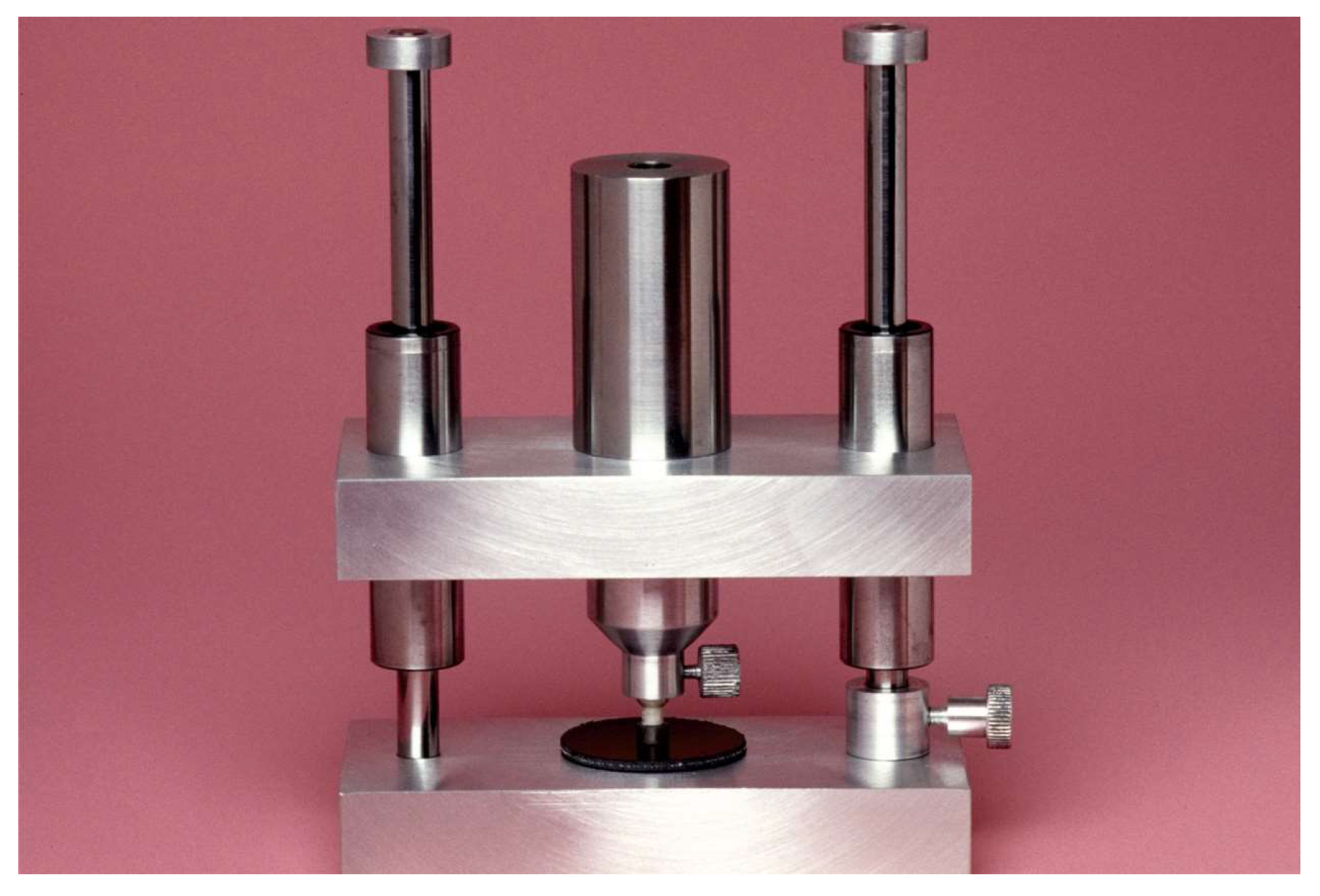
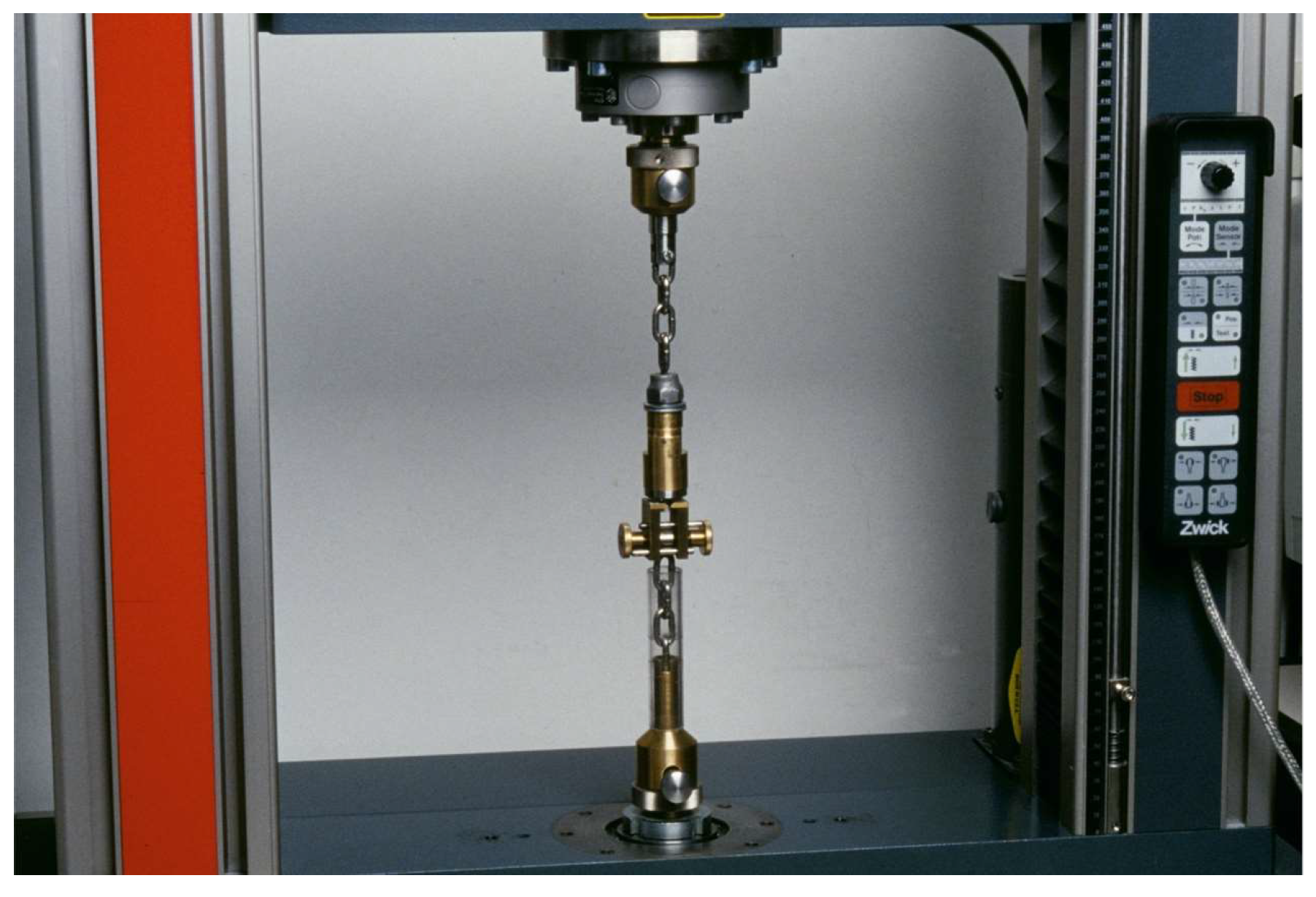
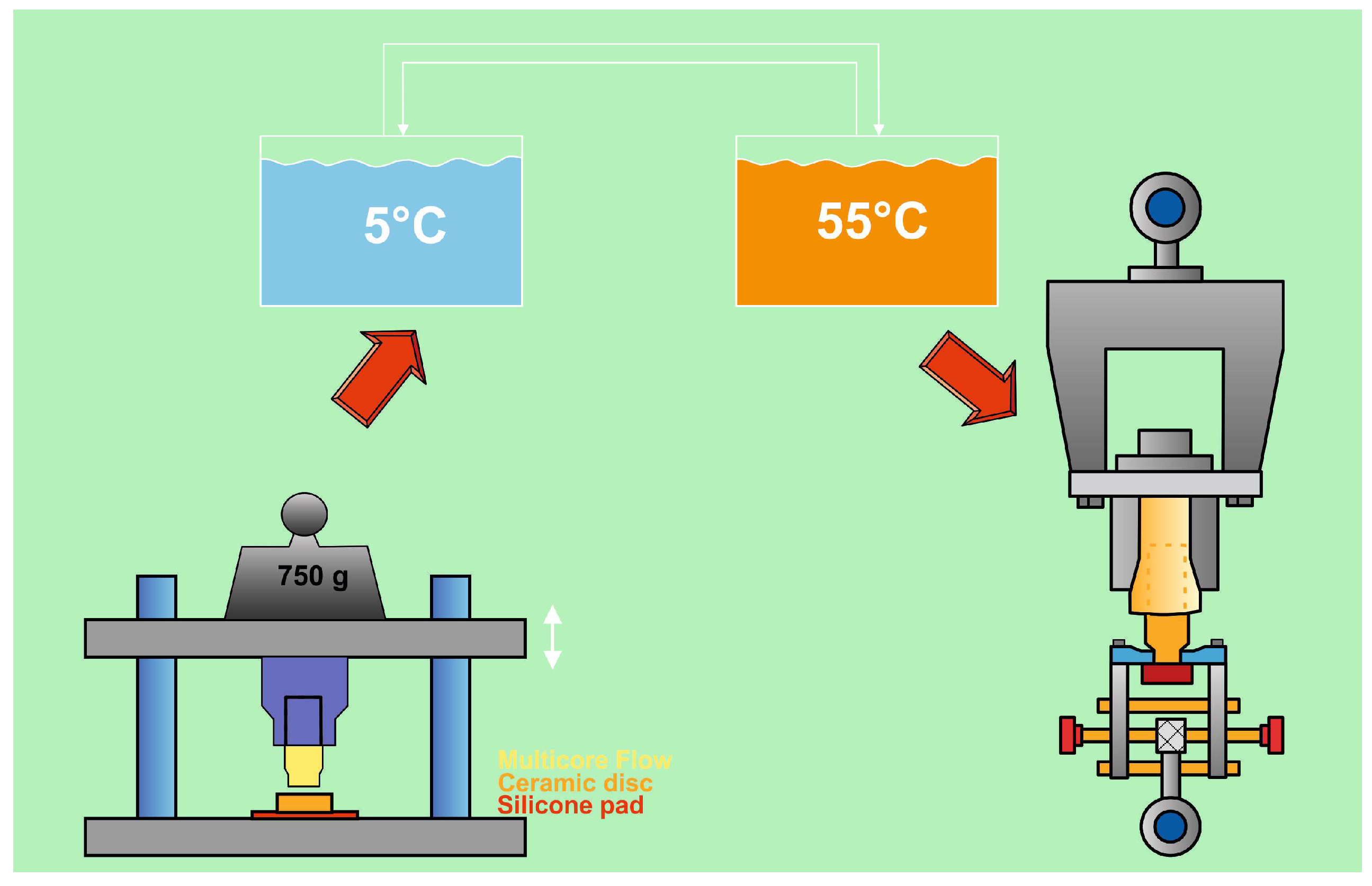
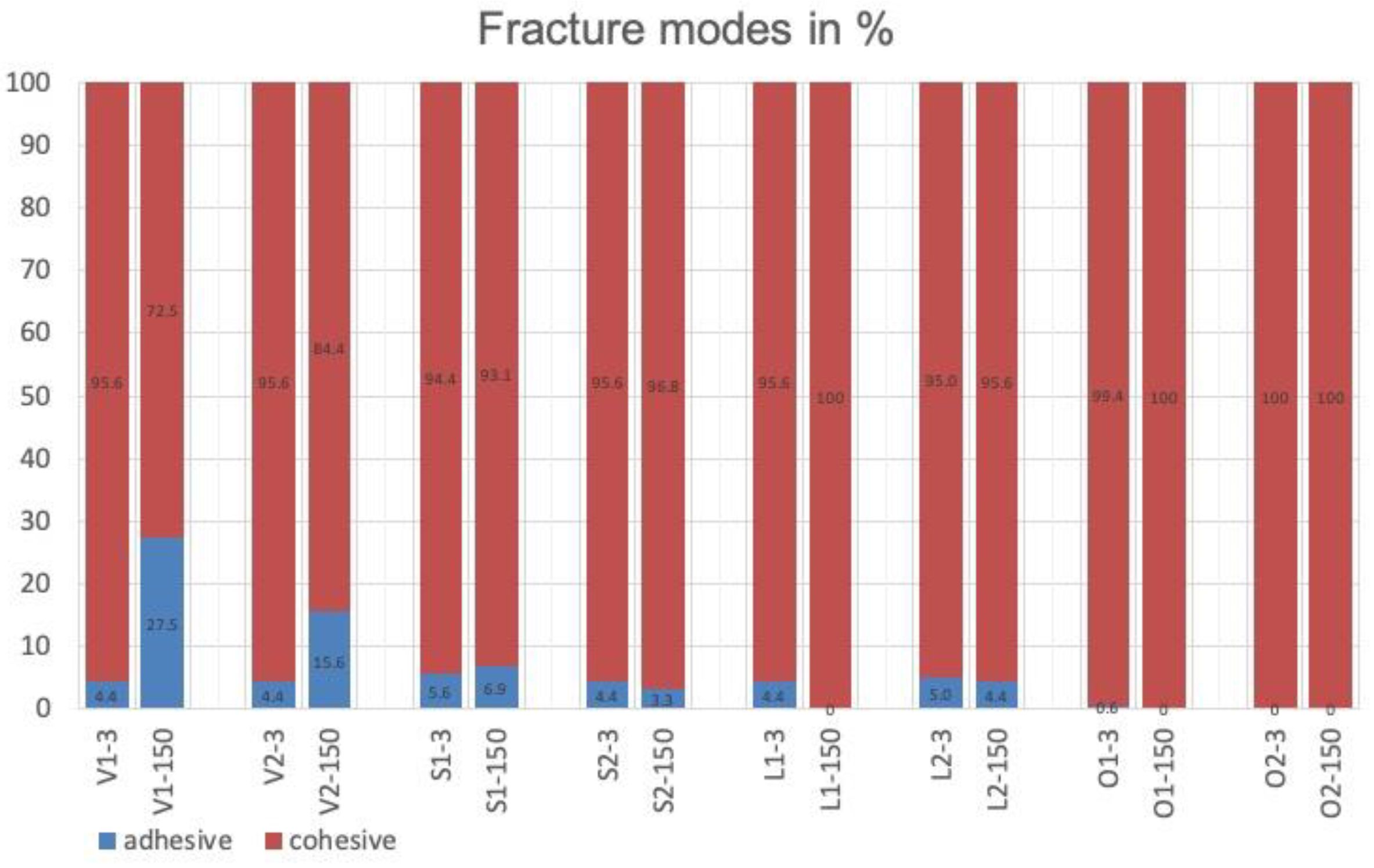
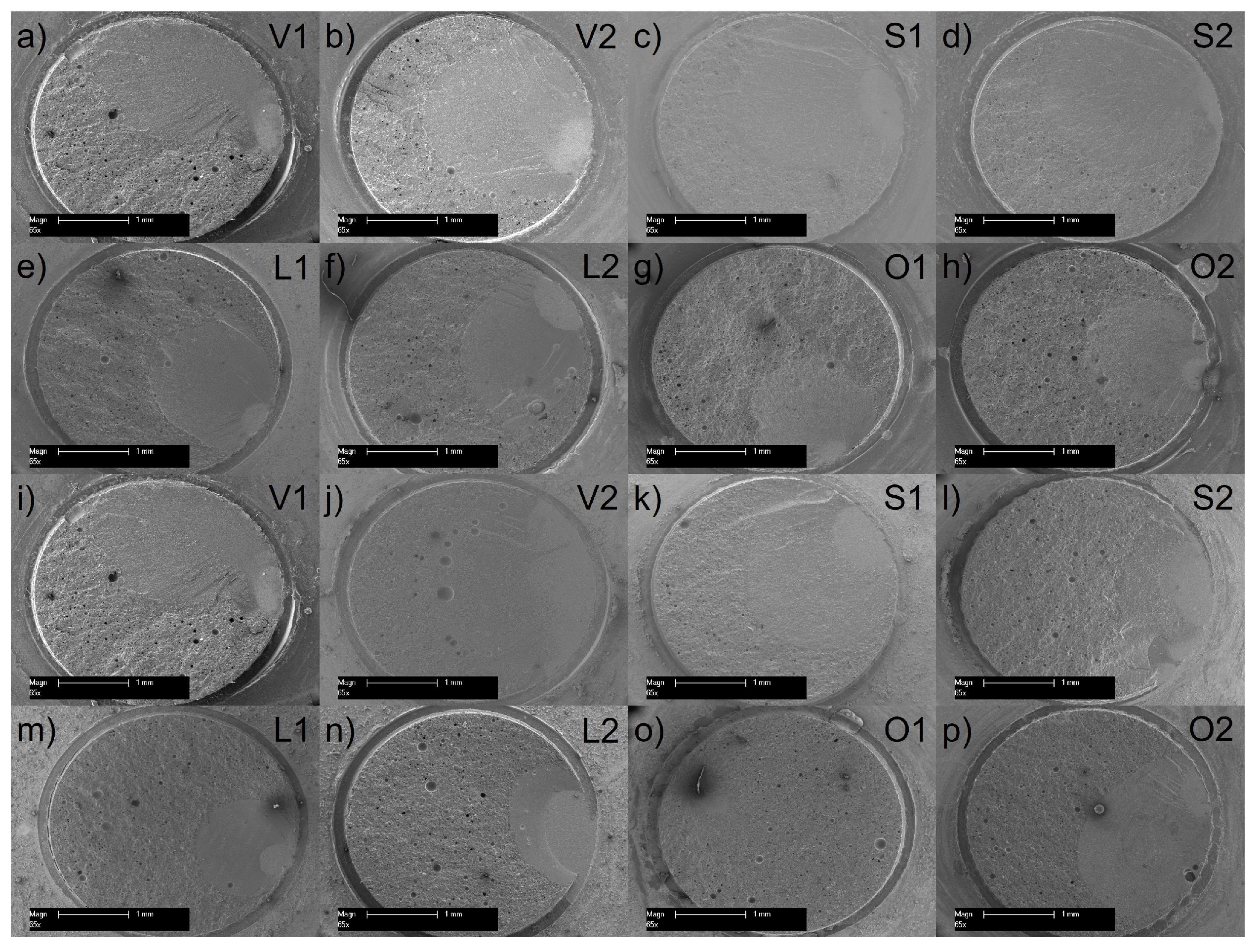
| Material | Composition | Manufacturer |
|---|---|---|
| Ceramic Primer Plus | 3-Methacryloxypropyl trimethoxysilane, ethanol, 10-methacryloyloxydecyl dihydrogen phosphate (MDP) | Kuraray Noritake Dental Inc. |
| Alloy Primer | Acetone, 10-methacryloyloxydecyl dihydrogen phosphate (MDP), 6-(4-vinylbenzyl-n-propyl) amino-1,3,5-triazine-2,4-dithione (VBATDT) | Kuraray Noritake Dental Inc. |
| G-MULTI PRIMER | Ethanol, methacryloyloxydecyl dihydrogen phosphate (MDP), methacryloyloxydecyl dihydrogen thiophosphate (MDTP), γ-methacryloxypropyl trimethoxysilane (Silane), methacrylate monomer | GC International, Luzern, Switzerland |
| G-CEM LinkForce | Paste A: bis-GMA, urethanedimethacrylate, dimethacrylate, barium glass, initiator, pigments Paste B: bis-MEPP, urethanedimethacrylate, dimethacrylate, barium glass, initiator | GC International |
| G-CEM One | Paste A: fluoroaluminosilicate glass, UDMA, dimethacrylate, initiator, stabilizer, pigment, silicondioxide, MDP Paste B: SiO2, trimethoxysilane, UDMA, 2-hydroxy-1,3-dimethacryloxypropane, MDP, 6-tert-butyl-2,4-xylenol, 2,6-di-tert-butyl-p-cresol, EDTA disodium salt dehydrate, vanadyl acetylacetonate, TPO, ascorbic acid, camphorquinone, MgO | GC International |
| Panavia SA | Paste A: 10-methacryloyloxydecyl dihydrogen phosphate (MDP), bisphenol A diglycidylmethacrylate (Bis-GMA), triethyleneglycol dimethacrylate (TEGDMA), hydrophobic aromatic dimethacrylate, 2-hydroxymethacrylate (HEMA), silanated barium glass filler, silanated colloidal silica, dl-camphorquinone, peroxide, catalysts, pigments Paste B: hydrophobic aromatic dimethacrylate, silane coupling agent, silanated barium glass filler, aluminum oxide filler, surface-treated sodium fluoride (less than 1%), dl-camphorquinone, accelerators, pigments | Kuraray Noritake Dental Inc. |
| Panavia V5 | Paste A: bisphenol A diglycidylmethacrylate (Bis-GMA), triethyleneglycol dimethacrylate (TEGDMA), hydrophobic aromatic dimethacrylate, hydrophilic aliphatic dimethacrylate, initiators, accelerators, silanated barium glass filler, silanated fluoroaluminosilicate glass filler, colloidal silica. Paste B: bisphenol A diglycidylmethacrylate (Bis-GMA), hydrophobic aromatic dimethacrylate, hydrophilic aliphatic dimethacrylate, silanated barium glass filler, silanated aluminum oxide filler, accelerators, dl-camphorquinone, pigments | Kuraray Noritake Dental Inc. |
| Groups | 3 Days | 150 Days | |||
|---|---|---|---|---|---|
| Mean (SD) | Median | Mean (SD) | Median | Impact by Aging | |
| V1 | 51.2 ± 5.7 a, BC | 50.1 | 13.6 ± 2.5 b, D | 13.7 | −73% |
| V2 | 47.7 ± 6.3 a, C | 49.4 | 17.0 ± 3.6 b, CD | 16.4 | −64% |
| S1 | 43.4 ± 5.0 a, C | 45.3 | 24.7 ± 7.7 b, BCD | 27.2 | −43% |
| S2 | 45.8 ± 6.6 a, C | 44.6 | 28.3 ± 9.0 b, BC | 29.9 | −38% |
| L1 | 60.2 ± 8.5 a, ABC | 61.1 | 41.8 ± 12.0 b, AB | 40.2 | −31% |
| L2 | 59.5 ± 8.2 a, ABC | 61.7 | 36.1± 14.0 b, ABC | 35.3 | −39% |
| O1 | 66.4 ± 3.5 a, A | 68.2 | 50.1 ± 9.4 b, A | 49.9 | −25% |
| O2 | 62.0 ± 5.5 a, AB | 63.9 | 42.2 ± 5.0 b, A | 41.6 | −32% |
Disclaimer/Publisher’s Note: The statements, opinions and data contained in all publications are solely those of the individual author(s) and contributor(s) and not of MDPI and/or the editor(s). MDPI and/or the editor(s) disclaim responsibility for any injury to people or property resulting from any ideas, methods, instructions or products referred to in the content. |
© 2024 by the authors. Licensee MDPI, Basel, Switzerland. This article is an open access article distributed under the terms and conditions of the Creative Commons Attribution (CC BY) license (https://creativecommons.org/licenses/by/4.0/).
Share and Cite
Yazigi, C.; Alawi, S.; Wille, S.; Lehmann, F.; Kern, M. Durability of Resin Bonding to Dental 3Y-TZP Zirconia Using Different Adhesive Systems. Materials 2024, 17, 424. https://doi.org/10.3390/ma17020424
Yazigi C, Alawi S, Wille S, Lehmann F, Kern M. Durability of Resin Bonding to Dental 3Y-TZP Zirconia Using Different Adhesive Systems. Materials. 2024; 17(2):424. https://doi.org/10.3390/ma17020424
Chicago/Turabian StyleYazigi, Christine, Shila Alawi, Sebastian Wille, Frank Lehmann, and Matthias Kern. 2024. "Durability of Resin Bonding to Dental 3Y-TZP Zirconia Using Different Adhesive Systems" Materials 17, no. 2: 424. https://doi.org/10.3390/ma17020424
APA StyleYazigi, C., Alawi, S., Wille, S., Lehmann, F., & Kern, M. (2024). Durability of Resin Bonding to Dental 3Y-TZP Zirconia Using Different Adhesive Systems. Materials, 17(2), 424. https://doi.org/10.3390/ma17020424








